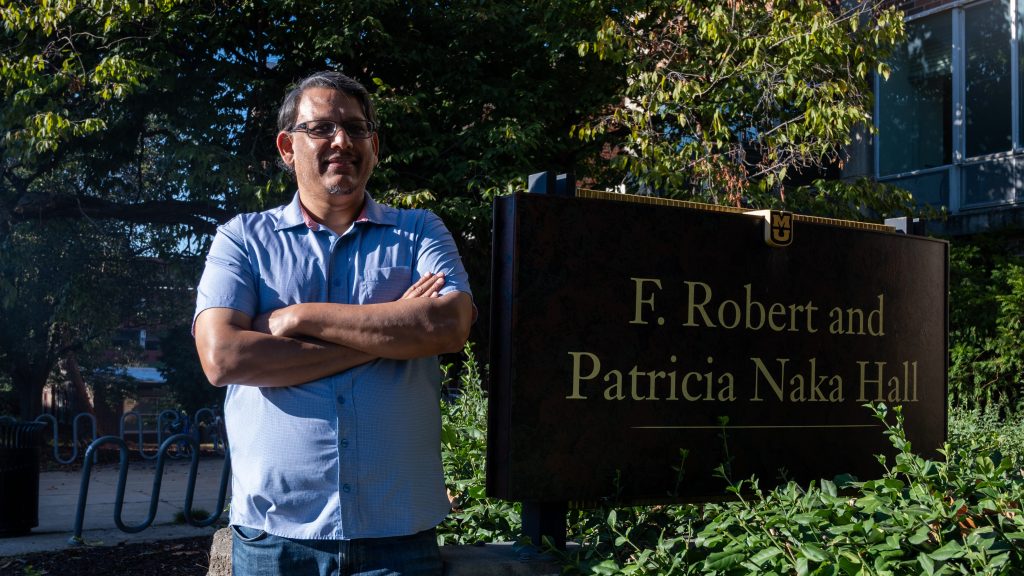October 12, 2025
A visionary project would give academic researchers access to next-level computing resources to supercharge their work.

At Mizzou Engineering, we seek more than one-off achievements. Here, we focus our energies on enduring accomplishments that empower others to create meaningful change on their own.
Right now, a team of researchers are spearheading an effort to provide university faculty, researchers, and students with a powerful, no-cost way to train custom language models to solve the most intractable problems.
Led by Praveen Rao, associate professor in the Department of Electrical Engineering and Computer Science, the project harnesses the powerful FABRIC research infrastructure, a distributed network of computing and storage resources funded by the National Science Foundation (NSF).
“Up to now, generative AI was an exclusive club of large companies with deep pockets who could pretrain large language models (LLMs) on massive datasets,” Rao said. “We want to level the playing field so academics can compete in this area.”
Generative AI tools have become commonplace. At an April 2025 TED conference, OpenAI CEO Sam Altman claimed that his company’s ChatGPT tool had 500 million users weekly.
Such tools are powered by LLMs, AI systems that use advanced statistics — and tons of computing power — to uncover patterns in vast troves of data and generate responses.
LLMs pretrained on large datasets can be fine-tuned for specific tasks, like medical research or legal analysis. But research has shown that models trained on specific fields (e.g., medicine, law) are more accurate than fine-tuned LLMs for those tasks.
“The more data the LLM trains on, the more accurate and nuanced its answers can be,” Rao said. “But in academic research, data is often limited, so most institutions find it easier to train and experiment with smaller language models.”
Academic researchers can pretrain models using standard, free-to-use graphic processing units (GPUs). However, these powerful chips can vary in speed, memory and capabilities, making the training process slow, unstable and difficult to distribute efficiently.
Rao’s two-year project overcomes these barriers. By leveraging FABRIC, researchers will be able to pretrain LMs on their own datasets and run inference tasks efficiently at scale. But it has never been tried before, for several reasons.
For one, FABRIC uses many different types of GPUs, with different speeds, capabilities and requirements. Furthermore, the networking capabilities of FABRIC can be exploited in a novel way.
“Writing efficient code and managing tasks across such a mix is tricky,” Rao said. “It’s a bit like trying to get a team of people who speak different languages to work together smoothly.”
FABRIC works at speeds much faster than your home internet, so it requires special hardware, software and expertise. Finally, FABRIC is a computing cluster with many nodes, so care needs to be taken to keep data secure.
Managing all this complexity is beyond the budgets of most academic researchers, until now. Rao’s project, funded by a $500,000 NSF grant, aims to give those researchers access to FABRIC, enabling them to train their own language models on large datasets.
The benefits would extend far beyond Mizzou.
“Once we make the framework open source, we would like to share the technology publicly, especially with our sister campuses in Kansas City, Rolla and St. Louis,” Rao said.
In addition to sharing their findings, tools and data, the team will develop new courses to train students to use generative AI effectively. These students and others could then easily pretrain their own language models and use them in their research — efficiently, at no charge.
At present, Rao is developing novel techniques and conducting preliminary experiments on FABRIC using open-source frameworks. He is recruiting new PhD students for the spring semester.
“This project is the next step in unlocking the full potential of generative AI and directing it where it can do the most good,” Rao said. “It’s a long journey, and it starts here.”
Mizzou Engineering is seeking grad students for this and other research projects. Learn how you can join us.